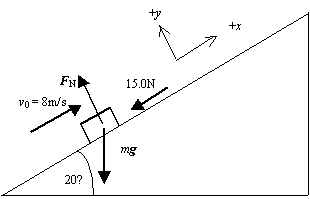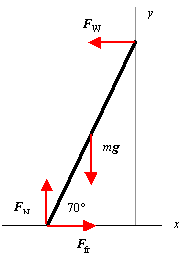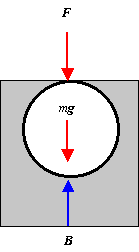| Solution. (a) We draw free-body diagram and choose the
coordinate system as shown. We take y = 0 at the bottom of the incline.
The non-conservative force is friction force. The normal is perpendicular to the direction of motion hence it does not do work. Thus we have WNC = Ffrd The energy of the block at the bottom of the incline is Ei = KEi + PEi = 1/2mv02 + 0; The energy of the block when the block stops is Ef = KEf + PEf = 0 + mgy; We find y from y = dsin20°. From conservation of energy we have - WNC = DE = Ef - Ei = mgy - 1/2mv02; -(15.0N)d = (4.00kg)(9.80m/s)dsin20° - 1/2(4.00kg)(8.00m/s)2, which gives d =4.51m (b) On the incline the forces acting on the block along the surface are mgsin20.0° and Ffr; since mgsin20.0° = 13.4N < 15N = Ffr, the block will not slide back down the incline. |
 |
Solution.
(a) For the elastic collision of the two balls., we use momentum conservation:
m1v1 + m2v2 = m1v1' + m2v2';
(0.22kg)((5.5m/s) + m2(0) = (0.22kg)(-37m/s) + m2v1'.
Because the collision is elastic, the relative speed does not change:
v1 - v2 = -(v1' - v2'), or 5.5m/s - 0 = v1' - (-3.7m/s), which gives v2' = 1.8m/s.
(b) Using the result for v2' in the momentum equation, we get m2 = 1.1kg.
| Solution. We choose the coordinate system as shown.
We write SF = ma from the force diagram: x- component: SFx = Ffr - FW = 0; y- component: SFy = FN - mg = 0. From FN = mg and Ffr = msFN, we have FW = Ffr = msmg. We write St = 0 about the pivot at ground: St = mg(1/2)(5m)cos70° - FW(5m)sin70° = 0, which gives FW = 1/2mgcos70°/sin70° = (1/2)(15kg)(9.80m/s2)cos70°/sin70° = 26.75N = Ffr . Thus we have ms = Ffr/FN = (26.75N)/[(15kg)(9.80m/s2)] = 0.182 |
 |
| Solution. At equilibrium, SF
= 0 or
F + mg - B = 0, where B is the buoyant force. Thus we have the applied force from F = B - mg We calculate B from B = rwaterVg, and we find the mass of the ball from m = V rballg, so we have F = Vg(rwater - rball) = 4/3pr3g(rwater - rball) = 4/3p(1.90 x 10-2m)3(9.80m/s2)(103kg/m3 - 84kg/m3) = 0.258N.
|
 |